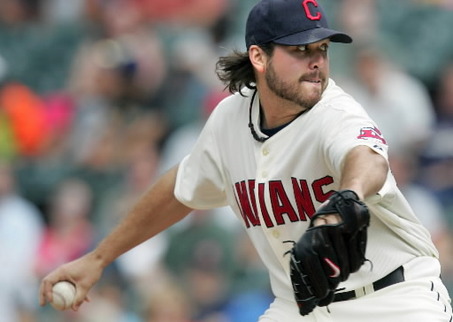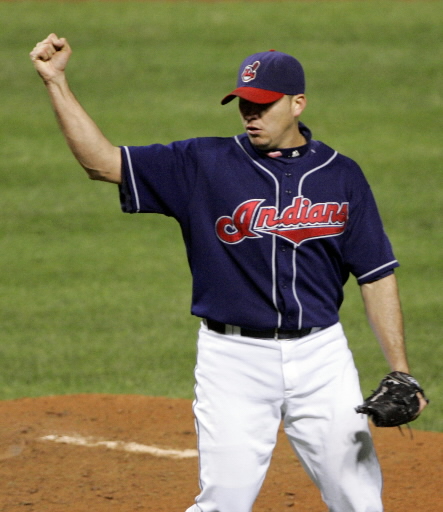
The 2007 Cleveland Indians came within one game of winning a World Series. Sure, they would have had to go through the formality of beating the Colorado Rockies, but nothing anyone can say will convince me that they would have put up much of a fight. The strength of that 2007 team was in its bullpen. Raffy Right (307 ERA+), Raffy Left (255 ERA+), Jensen Lewis (213 ERA+) and Aaron Fultz (156 ERA+) all had career seasons. Even Joe Borowski “nailed down” 45 saves despite an ERA+ of just 89.
Hell, even “Nasty” Tom Mastny posted a solid (for him) ERA+ of 97. Paul Byrd, Jake Westbrook and a smattering of fifth starters (including Cliff Lee) were spared the necessity of pitching out of the 6th inning. If the game was close after 5, the Indians had an advantage over every team in the league because of their dominant bullpen.
Fast-forward to 2008. The Indians are the media darlings of baseball, picked by many to go to the World Series. But the team stumbles out of the gate, thanks in part to the disaster that was the 2008 bullpen. Betancourt is a shell of his former self (85 ERA+). Borowski blows most of the leads that do make it to him in the 9th, and he is quickly on the DL and out of baseball. Masa Kobayashi (95 ERA+), Eddie Mjuica (64 ERA+) and Juan Rincon (77 ERA+) are called upon to “save” the bullpen. Only Raffy Left (121 ERA+) and Jensen Lewis (112 ERA+) turn in passable seasons out of the pen.
What happened? Did a lot of guys go off the juice at the exact same time? Did Luis Isaac forget how to be a good bullpen coach? Is Eric Wedge, in fact, the anti-Christ? Dismissing those three as unlikely options, we are led to believe that the bullpen is simply the most volatile segment of a baseball team. For example, Rafael Betancourt has posted the following numbers as his ERA+ since coming into the league in 2003:

2003: 208
2004: 112
2005: 151
2006: 118
2007: 307
2008: 85
2009: 165
2010: 129
Yikes. That’s an average of about 159, but with a 307 and 85 thrown in for good measure. He basically went from being the best relief pitcher in baseball to Derek Lilliquist in one offseason. And it’s not just the Indians. MLB is littered with closers given terrible contracts after a good season or two. Francisco Rodriguez, J.J. Putz, Bobby Jenks, B.J. Ryan, Mike Gonzalez, Brad Lidge…the list goes on and on. Remember Billy Koch? What about Rob Nen? Coming to the 2011 list, Octavio Dotel! The moral of the story is simple…relief pitchers are an extremely volatile commodity that cannot be counted on to be consistent from year-to-year. Guys like Nen can be out of this world one year, then injured or ineffective the next. That’s why guys like Mariano Rivera and Joe Nathan are so rare and valuable. And even Nathan missed 2010 after having Tommy John surgery, so who knows what 2011 will bring for the big righthander.
What does all this mean for the Indians? Well, when 2008 came and went with no internal options to replace the faltering big league bullpen, Mark Shapiro and company seemed to have learned a valuable lesson. The Indians have a wav…uh, gaggle of arms at every level of the minors that represent viable bullpen options for 2011-13 and beyond. For those who are sick of the Borowskis and Sowers’ of the world who can barely break a pane of glass with their respective fastballs, these guys throw HARD. Some touch triple digits. Most sit comfortably in the low to mid-90’s, and can reach back for more. All have the ability to miss bats. What does this mean? One, it means there are internal options within the system if the big league bullpen options fail, absolving the need to waste a valuable prospect bullet on a mid-season trade. Two, it means that the aspect of a team that varies the most from season to season does not have to be filled via the more expensive free agency route. For a team that is as cost-conscious as the Indians must be, this cannot be overstated. Pauly C. has well-documented some of the contracts that have been doled out to relievers this offseason. They are expensive, and they are far from sure things. Would you rather pay Kevin Correia $4 million in 2011, or save that money to go overslot late in the draft and give one of the kids a chance to prove himself at the major league level? Yeah, that’s what I thought.
Let’s take a quick look at some of those bullpen options by level, starting at MLB and working our way down to High-A. The players are listed below with their projected assignment for the beginning of the 2011 season, but that is of course subject to change. All #’s are from 2010 or as otherwise noted.
Cleveland:
Hurricane Perez: 226 ERA+, 61 K in 63 IP (acquired via trade in 2009)
Tony Sipp: 94 ERA+ 69 K in 63 IP (45th round pick in 2004)
Columbus:
Zach Putnam: 65 K in 75 2/3 IP (5th round pick in 2008)

Bryce Stowell: 102 K in 67 1/3 IP (22nd round pick in 2008)
Vinnie Pestano: 77 K in 59 2/3 IP (20th round pick in 2006)
Chen Lee: 82 K in 72 2/3 IP (International FA in 2008)
Jess Todd: 53 K in 49 IP (acquired via trade in 2009)
Josh Judy: 57 K in 49 IP (34th round pick in 2007)
*Hector Rondon: 137 K in 141 1/3 IP in 2009 (International FA in 2005)
*Rondon had TJ surgery in 2010 and has been a starter for his entire career so far, but even before the injury and surgery I had him pegged for the bullpen eventually due to a lack of a 3rd quality pitch.
Akron:
Cory Burns: 81 K in 55 IP (8th round pick in 2009)

Rob Bryson: 80 K in 50 1/3 IP (acquired via trade in 2008)
Nick Hagadone: 89 K in 82 2/3 IP (acquired via trade in 2009)
Brian Price: 69 K in 69 1/3 IP (acquired via trade in 2009)
Kinston (soon to be Zebulon):
*Jason Knapp: 47 K in 28 1/3 IP (acquired via trade in 2009)
Chris Jones: 85 K in 89 2/3 IP (15th round pick in 2007)
Preston Guilmet: 79 K in 52 IP (9th round pick in 2009)
Matt Langwell: 58 K in 56 IP (11th round pick in 2008)
*Some scouts see Knapp as a bullpen arm at this point, mostly due to his injury history. I still think he can start, but if he ends up in the ‘pen he has closer-level talent. For his minor league career, he has 208 K in 156 1/3 IP.
Notice a pattern there? Almost all of those guys average at least a strikeout per inning, and all but 5 were acquired in 2008 or later. Clearly there was an organizational shift after the disastrous start to the 2008 season. Whether the club publicly announces it or not, a key building block of “The Plan” 2.0 is clearly hard-throwing relievers with the ability to miss bats. Will all of these guys find success at the corner of Carnegie and Ontario? Hardly. But I’ll give any of those top ten options a shot in Cleveland in 2011 before I spend $4 million on Jesse Crain and hope that he’s v.2010 for the next three years and doesn’t regress to v.2009. Again, having this plethora of internal options for bullpen slots allows for a stable of cheap replacements when someone in the MLB bullpen inevitably falters, and precludes the need to deal legit prospects for MLB bullpen options, which can have disastrous long-term consequences. Jeff Bagwell for Larry Andersen is just the most notable example of such a trade, but hardly the only one. There are plenty of question marks for the Tribe going into 2011, but young, cheap bullpen arms is not one of them.